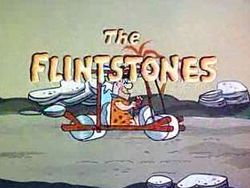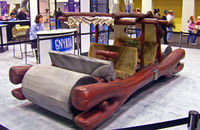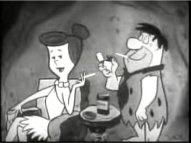The Flintstones
| The Flintstones | |
|---|---|
 Title screen from Seasons 1 – 3 in color. |
|
| Genre | Sitcom |
| Format | Animated series |
| Created by | William Hanna Joseph Barbera |
| Starring | Alan Reed Jean Vander Pyl Mel Blanc Bea Benaderet (Seasons 1–4) Gerry Johnson (Seasons 5–6) |
| Theme music composer | Hoyt Curtin |
| Country of origin | United States |
| Language(s) | English |
| No. of seasons | 6 |
| No. of episodes | 166 (List of episodes) |
| Production | |
| Running time | 30 minutes |
| Production company(s) | Hanna–Barbera Screen Gems |
| Broadcast | |
| Original channel | ABC |
| Original run | September 30, 1960 – April 1, 1966 |
| Chronology | |
| Followed by | The Pebbles and Bamm-Bamm Show |
The Flintstones is an animated American television sitcom that ran from September 30, 1960 to April 1, 1966 on ABC. Produced by Hanna-Barbera Productions, The Flintstones is about a working class Stone Age man's life with his family and his next door neighbor and best friend. It has since been re-released on both DVD and VHS.
Critics and fans alike agree that the show was an animated imitation of The Honeymooners with rock puns thrown in. It aired during an era when color television was becoming popular in America. Its popularity rested heavily on its juxtaposition of modern-day concerns in the Stone Age setting.[1][2]
Overview
The show is set in the Stone Age town of Bedrock. (In some of the earlier episodes, it was also referred to as "Rockville"). In this fantasy version of the past, dinosaurs, saber-toothed tigers, woolly mammoths, and other long extinct animals co-exist with barefoot cavemen. Like their 20th century peers, these cavemen listen to records, live in split-level homes, and eat out at restaurants, yet their technology is made entirely from pre-industrial materials and largely powered through the use of various animals. For example, the cars are made out of stone, wood, and animal skins, and powered by the passengers' feet. The characters are Fred Flintstone, Barney Rubble, Wilma Flintstone, Betty Rubble, Pebbles Flintstone, and Bamm-Bamm Rubble.
Technology
Often the "prehistoric" analogue to a modern machine uses an animal. For example, when a character takes photographs with an instant camera, inside of the camera box, a bird carves the picture on a stone tablet with its bill. In a running gag, the animal powering such technology breaks the fourth wall, looks directly into the camera at the audience, shrugs, and remarks, "It's a living." Other commonly seen gadgets in the series include a baby woolly mammoth used as a vacuum cleaner; an adult woolly mammoth acting as a shower by spraying water with its trunk; elevators raised and lowered by ropes around brontosauruses' necks; "automatic" windows powered by monkeys on the outside; birds acting as "car horns," sounded by the driver pulling on their tails or squeezing their bodies; an "electric" razor made from a clam shell, vibrating from a honey-bee inside; a washing machine shown by a pelican with a beakful of soapy water; and a woodpecker whose beak is used to play a gramophone record.
"Stone-age" names
The Stone Age setting allowed for gags and puns involving rocks. For example, San Antonio becomes Sand-and-Stony-o: the country to the south of Bedrock's land is called Mexirock. (Travel to "Hollyrock," a parody of Hollywood, usually involves an "airplane" flight—the "plane" in this case shown as a giant pterodactyl.) The last names "Flintstone" and "Rubble" are in line with these puns. So are the names of Bedrock's celebrities: "Cary Granite" (Cary Grant), "Stony Curtis" (Tony Curtis), "Ed Sulleyrock/Sulleystone" (Ed Sullivan), "Rock Pile/Quarry/Hudstone" (Rock Hudson), "Ann-Margrock" (Ann-Margret), "Jimmy Darrock" (James Darren), "Alvin Brickrock" (Alfred Hitchcock), "Perry Masonary/Masonite" (Perry Mason as played by Raymond Burr), "Mick Jadestone and The Rolling Boulders" (Mick Jagger and The Rolling Stones), "Eppy Brianstone" (Brian Epstein) and "The Beau Brummelstones" (The Beau Brummels). In some cases, the celebrity featured also provided the voice: "Samantha" and "Darrin" from "Bewitched" were voiced by Elizabeth Montgomery and Dick York. Examples from the above list include Ann-Margret, Curtis, Darrin, and the Beau Brummels. Other celebrities, such as "Ed Sulleystone" and "Alvin Brickrock", were rendered by impersonators.
The characters
The Flintstones


| Character | Role |
|---|---|
| Fred Flintstone | The main character. Fred is an accident-prone quarry worker and head of the Flintstone clan. He is quick to anger (usually over inconsequential matters), but a very loving husband and father. |
| Wilma Pebble Slaghoople Flintstone | Fred's wife. She is more intelligent and level-headed than her husband, though she often has a habit of spending money. |
| Pebbles Flintstone | The Flintstones' daughter. |
| Dino | The Flintstones' pet dinosaur, who barks like a dog. |
| Baby Puss | The Flintstones' pet saber toothed cat. |
| Doozy | The Flintstones' pet Dodo Bird. |
Extended family
| Character | Role |
|---|---|
| Pearl Pebble Slaghoople | Wilma's mother. |
| Ed Flintstone | Fred's father; mechanic. |
| Edna Hardrock Flintstone | Fred's mother |
| Zeke Flintstone | Fred's uncle, who owned Sandstone Cemente, a pun on the California town, San Clemente. |
| Tex Hardrock | Fred's uncle on his mother's side. |
| Jemina Hardrock | Fred's aunt. |
| Uncle Giggles | Fred's eccentric uncle who lived on Nightmare Hill (a spoof of House on Haunted Hill). |
The Rubbles

| Character | Role |
|---|---|
| Barney Rubble | Fred's best friend and next door neighbor. He and Fred are both members of the fictional "Loyal Order of Water Buffaloes" (Lodge No. 26), a men-only club paralleling real-life fraternities such as the Freemasons. |
| Betty Rubble | Barney's wife and best friend of Wilma. |
| Bamm-Bamm Rubble | The Rubbles' abnormally strong adopted son; his name comes from the only phrase he ever spoke as a baby: "Bamm, Bamm!" |
| Hoppy | The Rubbles' pet Hopparoo (a kangaroo/dinosaur combination creature). |
Other characters
| Character | Role |
|---|---|
| Arnold | The Flintstones' paper boy. A running gag is Fred being outsmarted by Arnold. |
| The Great Gazoo | An alien exiled to Earth who helps Fred and Barney, often against their will. |
| Joe Rockhead | A friend of Fred's. |
| Mr. Slate | Fred's hot tempered boss at the stone quarry. |
Voices
It has been noted that Fred Flintstone physically resembled voice actor Alan Reed, and also Jackie Gleason. The voice of Barney was provided by legendary voice actor Mel Blanc, though five episodes (the 1st, 2nd, 5th, 6th, and 9th) during the second season employed Hanna-Barbera regular Daws Butler while Blanc was incapacitated by a near-fatal car accident. Blanc was able to return to the series much sooner than expected, by virtue of a temporary recording studio for the entire cast set up at Blanc's bedside. It should be noted, however, that Blanc's portrayal of Barney Rubble had changed considerably after the accident. In the earliest episodes, Blanc had used a much higher pitch. After his recovery from the accident, Blanc used a deeper voice.
Additional similarities with The Honeymooners included the fact that Reed based Fred's voice upon Jackie Gleason's interpretation of Ralph Kramden, while Blanc, after a season of using a nasal, high-pitched voice for Barney, eventually adopted a style of voice similar to that used by Art Carney in his portrayal of Ed Norton. The first time that the Art Carney-like voice was used was for a few seconds in "The Prowler" (the third episode produced).
In a 1986 Playboy interview, Jackie Gleason said that Alan Reed had done voice-overs for Gleason in his early movies, and that he (Gleason) considered suing Hanna-Barbera for copying The Honeymooners but decided to let it pass.[3] According to Henry Corden, who took over as the voice of Fred Flintstone after Alan Reed died, and was a friend of Gleason’s, “Jackie’s lawyers told him that he could probably have The Flintstones pulled right off the air. But they also told him, “Do you want to be known as the guy who yanked Fred Flintstone off the air? The guy who took away a show that so many kids love, and so many parents love, too?”
Henry Corden handled the voice responsibilities of Fred after Reed's death in 1977. Corden had previously provided Fred's singing voice in The Man Called Flintstone and later on Flintstones children's records. After 1999, Jeff Bergman performed the voice of Fred. Since Mel Blanc's death in 1989, Barney has been voiced by both Frank Welker and Kevin Richardson. Various additional character voices were created by Hal Smith, Allan Melvin, Janet Waldo, Daws Butler and Howard Morris, among others.
Voice cast
- Fred Flintstone – Alan Reed
Latin Spanish: Jorge Arvizu (who also made Spanish voice for Super Agent 86).
- Fred Flintstone – Henry Corden (singing voice)
- Wilma Flintstone – Jean Vander Pyl
- Pebbles Flintstone – Jean Vander Pyl (1963–1966)
- Barney Rubble/Dino – Mel Blanc
- Barney Rubble (season 2 episodes 1, 2, 5, 6, and 9 only) – Daws Butler
- Betty Rubble – Bea Benaderet (seasons 1-4/1960-1964)
- Betty Rubble – Gerry Johnson (seasons 5-6/1964-1966)
- Bamm-Bamm Rubble/Hoppy/Arnold – Don Messick (1963–1966)
While English dubbing is deep voice, Spanish version is very high pitched.
- Mrs. Slate – Jean Vander Pyl and Bea Benaderet
- The Great Gazoo – Harvey Korman
- Mr. Slate – John Stephenson
Music
The opening and closing credits theme during the first two seasons was called "Rise and Shine", a lively instrumental underscore accompanying Fred on his drive home from work. The tune resembled "The Bugs Bunny Overture (This is It!)," the theme song of "The Bugs Bunny Show", also airing on ABC at the time, and may have been the reason the theme was changed in the third season.
Starting in Season 3, Episode 3 ("Barney the Invisible"), the opening and closing credits theme was the familiar vocal, "Meet the Flintstones".
The musical underscores were credited to Hoyt Curtin for the show's first five seasons; Ted Nichols took over in 1965 for the final season.
A PRS for Music survey revealed that the Flintstones' theme tune was the most recognised kids TV theme tune amongst UK adults[4]
Production history
Originally, the series was to have been titled The Flagstones, and a brief demonstration film was created to sell the idea of a "modern stone age family" to sponsors and the network.[5]:3 When the series itself was commissioned, the title was changed, possibly to avoid confusion with the Flagstons, characters in the comic strip Hi and Lois. After spending a brief period in development as The Gladstones (Gladstone being a Los Angeles telephone exchange at the time),[6] Hanna-Barbera settled upon The Flintstones. Aside from the animation and fantasy setting, the show's scripts and format are typical of 1950s and 1960s American situation comedies, with the usual family issues resolved with a laugh at the end of each episode, as well as the inclusion of a laugh track.
Although most Flintstones episodes are stand-alone storylines, the series did have a few story arcs. The most notable example was a series of episodes surrounding the birth of Pebbles. Beginning with the episode "The Surprise", aired midway through the third season (1/25/63), in which Wilma reveals her pregnancy to Fred, the arc continued through the trials and tribulations leading up to Pebbles' birth in the episode "Dress Rehearsal" (2/22/63), and then continued with several episodes showing Fred and Wilma adjusting to the world of parenthood. In Australia, the Nine Network ran a "Name the Flintstones' baby" competition during the 'pregnancy' episodes – few Australian viewers were considered sophisticated enough to have a USA connection giving them information about past 'Flintstone' shows.

The Flintstones also became the first primetime animated series to last more than two seasons;[7] this record wasn't surpassed by another primetime animated TV series until the third season of The Simpsons in 1992.[7]
A postscript to the arc occurred in the third episode of the fourth season, in which the Rubbles, depressed over being unable to have children of their own (making The Flintstones the first animated series in history to address the issue of infertility, though subtly), adopt Bamm-Bamm. The 100th episode made (but the 90th to air), Little Bamm-Bamm (10/3/63), established how Bamm-Bamm was adopted. About nine episodes were made before it, but shown after, which explains why Bamm-Bamm would not be seen again until episode 101, Daddies Anonymous (Bamm-Bamm was in a teaser on episode 98, Kleptomaniac Pebbles). Another story arc, occurring in the final season, centered on Fred and Barney's dealings with The Great Gazoo (voiced by Harvey Korman).

The series was initially aimed at adult audiences, which was reflected in the comedy writing, which, as noted, resembled the average primetime sitcoms of the era. Hanna and Barbera hired many writers from the world of live-action (including two of Jackie Gleason's writers, Herbert Finn and Sydney Zelinka, as well as relative newcomer Joanna Lee) while still using traditional animation story men (like Warren Foster and Tony Benedict). The first two seasons were co-sponsored by Winston cigarettes and the characters appeared in several black and white television commercials for Winston (dictated by the custom, at that time, that the star{s} of a TV series often "pitched" their sponsor's product in an "integrated commercial" at the end of the episode). During the third season (the season in which Pebbles was born), Welch's (grape juice and grape jellies) became the primary sponsor, and the overall tone and writing of the series became more family friendly. Integrated commercials for Welch's products feature Pebbles asking for grape juice in her toddler dialect, and Fred explaining to Pebbles Welch's unique process for making the jelly, compared to the competition.
The Flintstones was the first American animated show to depict two people of the opposite sex (Fred and Wilma; Barney and Betty) sleeping together in one bed, although Fred and Wilma are sometimes depicted as sleeping in separate beds. For comparison, the first live-action depiction of this in American TV history was in television's first-ever sitcom: 1947's Mary Kay and Johnny.[8]
The show contained a laugh track, common to most other sitcoms of the period. In the mid-1990s, when Turner Networks remastered the episodes, the original laugh track was removed. Currently, the shows airing on Boomerang and the DVD releases have the original laugh track restored to most episodes (a number of episodes from Seasons 1 and 2 still lack them). Some episodes, however, have a newer laugh track dubbed in, apparently replacing the old one. Because of this practice, the only episode to originally air without a laugh track ("Sheriff For a Day" in 1965) now has one.
Reception
In January 2009, IGN named The Flintstones as the ninth best in its "Top 100 Animated TV Shows". [9]
Nielsen ratings
The show was a top 30 hit for its first three seasons according to ClassicTVHits.com
- 1960–1961: #18 (24.3 rating)
- 1961–1962: #21 (22.9 rating)
- 1962–1963: #30 (20.5 rating)
Films and subsequent TV series
Following the show's cancellation in 1966, a film based upon the series was created. The Man Called Flintstone was a musical spy caper that parodied James Bond and other secret agents. The movie was released to theaters on August 3, 1966 by Columbia Pictures. It was released on DVD in Canada in March 2005 and in United States in December 2008.
The show was revived in the early 1970s with Pebbles and Bamm-Bamm having grown into teenagers, and several different series and made-for-TV movies (broadcast mainly on Saturday mornings, with a few shown in prime time); including a series depicting Fred and Barney as police officers, another depicting the characters as children, and yet others featuring Fred and Barney encountering Marvel Comics superhero The Thing and comic strip character The Shmoo — have appeared over the years. The original show also was adapted into a live-action film in 1994, and a prequel, The Flintstones in Viva Rock Vegas, which followed in 2000.
Theme parks
At least two Flintstones-themed amusement parks exist in the United States, one in Custer, South Dakota and another in Arizona. Both have been in operation for decades. One previously existed in Australia at Australia's Wonderland as a Hanna Barbera theme, dominated by small children's rides, from 1985 up until the late '90s. Another existed until the 1990s at Carowinds in Charlotte, NC. There was also one in Canada, Flintstone Park in Kelowna, British Columbia opened in 1968 and closed in 1998; notable for the "Forty Foot Fred" statue of Fred Flintstone which was a well known Kelowna landmark.[10]
Live Theatre
A stage production opened at Universal Studios Hollywood in 1994 (the year the live action film was released), developed by Universal and Hanna-Barbera Productions. It opened at the Panasonic Theatre replacing the Star Trek Show. The story consists of Fred, Wilma, Barney and Betty heading for "Hollyrock". The show ran until January 2, 1997.
Original broadcast history
- ABC (1960–1966)
- September 1960 – September 1963 Friday 8:30–9:00
- September 1963 – December 1964 Thursday 7:30–8:00
- December 1964 – September 1966 Friday 7:30–8:00
Flintstones series and spin-offs
Television series
- The Flintstones (1960–66)
- The Pebbles and Bamm-Bamm Show (1971–72)
- The Flintstone Comedy Hour (1972–73)
- Fred Flintstone and Friends (1977–78)
- The New Fred and Barney Show (1979)
- Fred and Barney Meet the Thing (1979)
- Fred and Barney Meet the Shmoo (1979–80)
- The Flintstone Comedy Show (1980–82)
- The Flintstone Funnies (1982–84)
- The Flintstone Kids (1986–88)
- Dino: World Premiere Toons – featuring "Stay Out!" (1995) and "The Great Egg-Scape" (1997)
- Cave Kids: Pebbles & Bamm-Bamm (2000)
Theatrical animated feature
- The Man Called Flintstone (1966, released by Columbia Pictures)
Television specials
- A Flintstone Christmas (1977)
- The Flintstones: Little Big League (1978)
- The Flintstones Meet Rockula and Frankenstone (1979)
- The Flintstones' New Neighbors (1980)
- The Flintstones: Fred's Final Fling (1980)
- The Flintstones: Wind-Up Wilma (1981)
- The Flintstones: Jogging Fever (1981)
- The Flintstones' 25th Anniversary Celebration (1986)
- The Flintstone Kids' "Just Say No" Special (1988)
- A Yabba Dabba Doo Celebration: 50 years of Hanna-Barbera (1989)
- A Flintstone Family Christmas (1993)
Television movies
- The Jetsons Meet the Flintstones (1987)
- I Yabba-Dabba Do! (1993)
- Hollyrock-a-Bye Baby (1993)
- A Flintstones Christmas Carol (1994)
- The Flintstones: On the Rocks (2001)
Live action films
- The Flintstones (1994)
- The Flintstones in Viva Rock Vegas (2000)
Other media
- For a list of DVDs, video games, comic books, and VHS releases, see List of The Flintstones media.
Awards for The Flintstones
"The Flintstones" was nominated for an Emmy in 1961 for "Outstanding Program Achievement in the Field of Humor." They lost to "The Jack Benny Show."
Popular culture
As noted above, for the first two seasons, the series had strong ties to a sponsor, Winston cigarettes, with the characters shown smoking the product during commercial breaks. This approach was not unusual for television at that time, either with tobacco or any other product. In one memorable advertisement, Fred and Barney relaxed while their wives did housework, smoking Winstons and reciting Winston's jingle, "Winston tastes good like a cigarette should!"[11] In 1963, Winston pulled their sponsorship from the show when Wilma became pregnant; after that point, the main sponsor was Welch's Grape Juice.
Welch's advertised their product with animated commercials featuring the cartoon cast and they were often pictured in print ads and on grape juice containers. In the actual scenes of a few episodes, Pebbles is given grape juice as a treat, although, in those scenes, Welch's is not mentioned by name.
Miles Laboratories (now part of Bayer Corporation) and their One-A-Day vitamin brand was an alternate sponsor of the original Flintstones series, and in the late 1960s, Miles introduced Flintstones Chewable Vitamins, fruit flavored multivitamin tablets for children in the shape of the Flintstones characters, which are sold to this day.[12]
The characters from the series were used in an industrial film designed to promote the 1967 beer advertising campaigns for Anheuser-Busch. This film was released to the Anheuser-Busch distributors, and it was not seen by the general public until years later when bootleg copies began to circulate.[13]
The series spawned the Post Foods brands of Pebbles cereals: Fruity Pebbles and Cocoa Pebbles, and the discontinued Dino Pebbles (later revived as "Marshmallow Mania Pebbles", and then to "Marshmallow Pebbles").
More recently, the Flintstones have been seen in commercials for GEICO automotive insurance and Midas auto repair shops.
Fred Flintstone's exclamation 'Yabba Dabba Dooo!', shouted in the opening credits as well as any time Fred became happy or excited, is widely known and repeated.
The Screaming Blue Messiahs had a song called I Wanna Be a Flintstone on their album Bikini Red. It was later rereleased on the soundtrack album of the 1994 live action film The Flintstones.
"Weird Al" Yankovic paid homage to the Flintstones in his song "Bedrock Anthem", a combined parody of "Under the Bridge" and "Give it Away", both by the Red Hot Chili Peppers, that even featured Flintstones voices and sound effects. It also was rereleased on the soundtrack album of the 1994 live action film The Flintstones.
In 2008, Warner Brothers Theater Ventures announced that Jeff Marx, Jake Anthony and Marco Pennette would collaborate on a stage musical version of The Flintstones, with the plot putting a contemporary spin on the characters.[14] The proposed production stalled during negotiations.
Episodes
International Broadcast
 Chile
Chile
- TVN(1974–1992)
- Megavision (1992–1999)
- RED TV(2000–2003)
- TC Telecanal (2005–present)





 Latin America
Latin America
- Cartoon Network (1993–2004)
- Boomerang (2001–2006)
- Tooncast (2008–present)
See also
- Hanna-Barbera's All-Star Comedy Ice Revue – Hanna-Barbera characters honor Fred in an all-star celebrity roast for his birthday (1977)
- The Jetsons
- The Roman Holidays
- The Simpsons
- Bedrock (song)
- "(Meet) The Flintstones", a version of the show's theme song that became a hit single for The B-52s.
References
- ↑ CD liner notes: Saturday Mornings: Cartoons’ Greatest Hits, 1995 MCA Records
- ↑ "Flintstones, The - Season 1 Review". TVShowsOnDVD.com. http://www.tvshowsondvd.com/news/Site-News-BCI-Shut-Down/11064. Retrieved 2010-08-25.
- ↑ Zehme, Bill (interviewer) (August 1986). "Jackie Gleason – Playboy Interview – Life History". http://www.playboy.com/articles/jackie-gleason-1986-interview/index.html?page=2. Retrieved 2009-07-25.
- ↑ WENN (August 11, 2010). "The Flintstones boasts top tune". Yahoo News. http://uk.news.yahoo.com/1/20100811/ten-the-flintstones-boasts-top-tune-c60bd6d.html. Retrieved 2010-08-11.
- ↑ Barbera, Joseph (1994). My Life in "Toons": From Flatbush to Bedrock in Under a Century. Atlanta, GA: Turner Publishing. ISBN 1-57036-042-1.
- ↑ "The cartoon dream team". BBC News. 2001-03-21. http://news.bbc.co.uk/2/hi/entertainment/1237649.stm. Retrieved 2008-08-13.
- ↑ 7.0 7.1 "Cartoons". Museum.tv. 1989-04-12. http://www.museum.tv/archives/etv/C/htmlC/cartoons/cartoons.htm. Retrieved 2010-08-30.
- ↑ "First TV Couple in Same Bed". http://www.snopes.com/radiotv/tv/marykay.htm. Retrieved 2010-08-30.
- ↑ "IGN - 9. The Flintstones". Tv.ign.com. http://tv.ign.com/top-100-animated-tv-series/9.html. Retrieved 2010-08-30.
- ↑ "Remember Flintstones Park in Kelowna? Where there was Fred, there was food, beer and bowling - the same is true at Freddy's Brew Pub!". Mccurdybowl.com. 2009-02-16. http://www.mccurdybowl.com/freddys_brewpub_history.html. Retrieved 2010-08-30.
- ↑ Video of the commercial on YouTube
- ↑ Advertisements for the product are included in the DVD release for season 1.
- ↑ Phil Hall (August 27, 2004). "The Bootleg Files: Busch Advertising 1967". Film Threat. http://www.filmthreat.com/index.php?section=features&Id=1187. Retrieved 2009-02-15.
- ↑ Fick, David."THE FLINTSTONES: A YABBA DABBA MUSICAL" Musical Cyberspace, December 3, 2008
External links
- Museum of Broadcast Communications: The Flintstones
- Webrock: The Flintstones and Hanna-Barbera Site
- A film clip of television commercials for Winston cigarettes featuring The Flintstones is available for free download at the Internet Archive [more]
- The Flintstones page at Toonopedia
- The Flintstones at the Internet Movie Database
- The Flintstones at TV.com
- The Cartoon Scrapbook – Profile on The Flintstones.
|
||||||||||||||||||||||||||||||||||||||||